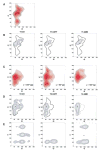A hydration study of (1-->4) and (1-->6) linked alpha-glucans by comparative 10 ns molecular dynamics simulations and 500-MHz NMR
- PMID: 14735575
- PMCID: PMC4201036
- DOI: 10.1002/jcc.10405
A hydration study of (1-->4) and (1-->6) linked alpha-glucans by comparative 10 ns molecular dynamics simulations and 500-MHz NMR
Abstract
The hydration behavior of two model disaccharides, methyl-alpha-D-maltoside (1) and methyl-alpha-D-isomaltoside (2), has been investigated by a comparative 10 ns molecular dynamics study. The detailed hydration of the two disaccharides was described using three force fields especially developed for modeling of carbohydrates in explicit solvent. To validate the theoretical results the two compounds were synthesized and subjected to 500 MHz NMR spectroscopy, including pulsed field gradient diffusion measurements (1: 4.0. 10(-6) cm(2). s(-1); 2: 4.2. 10(-6) cm(2). s(-1)). In short, the older CHARMM-based force field exhibited a more structured carbohydrate-water interaction leading to better agreement with the diffusional properties of the two compounds, whereas especially the alpha-(1-->6) linkage and the primary hydroxyl groups were inaccurately modeled. In contrast, the new generation of the CHARMM-based force field (CSFF) and the most recent version of the AMBER-based force field (GLYCAM-2000a) exhibited less structured carbohydrate-water interactions with the result that the diffusional properties of the two disaccharides were underestimated, whereas the simulations of the alpha-(1-->6) linkage and the primary hydroxyl groups were significantly improved and in excellent agreement with homo- and heteronuclear coupling constants. The difference between the two classes of force field (more structured and less structured carbohydrate-water interaction) was underlined by calculation of the isotropic hydration as calculated by radial pair distributions. At one extreme, the radial O em leader O pair distribution function yielded a peak density of 2.3 times the bulk density in the first hydration shell when using the older CHARMM force field, whereas the maximum density observed in the GLYCAM force field was calculated to be 1.0, at the other extreme.
Copyright 2004 Wiley Periodicals, Inc. J Comput Chem 25: 573-586, 2004
Figures








Similar articles
-
A combined nuclear magnetic resonance and molecular dynamics study of the two structural motifs for mixed-linkage beta-glucans: methyl beta-cellobioside and methyl beta-laminarabioside.Carbohydr Res. 2010 Feb 26;345(4):474-86. doi: 10.1016/j.carres.2009.12.009. Epub 2009 Dec 22. Carbohydr Res. 2010. PMID: 20079487
-
Glycosidic α-linked mannopyranose disaccharides: an NMR spectroscopy and molecular dynamics simulation study employing additive and Drude polarizable force fields.Phys Chem Chem Phys. 2023 Jan 27;25(4):3042-3060. doi: 10.1039/d2cp05203b. Phys Chem Chem Phys. 2023. PMID: 36607620 Free PMC article.
-
MMC and LD simulations of alpha-D-Manp-(1-->2)-beta-D-Glcp-OMe: comparison to long-range heteronuclear NMR coupling constants and to the crystal structure.Glycoconj J. 1998 Feb;15(2):183-6. doi: 10.1023/a:1006924424004. Glycoconj J. 1998. PMID: 9557879
-
Is AMOEBA a Good Force Field for Molecular Dynamics Simulations of Carbohydrates?J Chem Inf Model. 2025 Jun 9;65(11):5289-5300. doi: 10.1021/acs.jcim.5c00442. Epub 2025 May 20. J Chem Inf Model. 2025. PMID: 40392062 Free PMC article. Review.
-
The diluted aqueous solvation of carbohydrates as inferred from molecular dynamics simulations and NMR spectroscopy.Biophys Chem. 2001 Nov 28;93(2-3):103-27. doi: 10.1016/s0301-4622(01)00215-0. Biophys Chem. 2001. PMID: 11804720 Review.
Cited by
-
GLYCAM06: a generalizable biomolecular force field. Carbohydrates.J Comput Chem. 2008 Mar;29(4):622-55. doi: 10.1002/jcc.20820. J Comput Chem. 2008. PMID: 17849372 Free PMC article.
-
First principles insight into the alpha-glucan structures of starch: their synthesis, conformation, and hydration.Chem Rev. 2010 Apr 14;110(4):2049-80. doi: 10.1021/cr900227t. Chem Rev. 2010. PMID: 20302376 Free PMC article. Review. No abstract available.
-
TIP5P-Consistent Treatment of Electrostatics for Biomolecular Simulations.J Chem Theory Comput. 2007 Sep 1;3(5):1721-1733. doi: 10.1021/ct700046j. J Chem Theory Comput. 2007. PMID: 25419191 Free PMC article.
-
Molecular dynamics simulation of dextran extension by constant force in single molecule AFM.Biophys J. 2006 Nov 15;91(10):3579-88. doi: 10.1529/biophysj.105.079236. Epub 2006 Sep 1. Biophys J. 2006. PMID: 16950842 Free PMC article.
-
Solvation properties of N-acetyl-β-glucosamine: molecular dynamics study incorporating electrostatic polarization.J Comput Chem. 2011 Dec;32(16):3339-53. doi: 10.1002/jcc.21873. Epub 2011 Sep 7. J Comput Chem. 2011. PMID: 21898464 Free PMC article.
References
-
- Brady JW. J Am Chem Soc. 1989;111:5155.
-
- Engelsen SB, Hervé du Penhoat C, Pérez S. J Phys Chem. 1995;99:13334.
-
- Engelsen SB, Monteiro C, Hervé du Penhoat C, Pérez S. Biophys Chem. 2001;93:103. - PubMed
Publication types
MeSH terms
Substances
Grants and funding
LinkOut - more resources
Full Text Sources
Other Literature Sources
Miscellaneous

